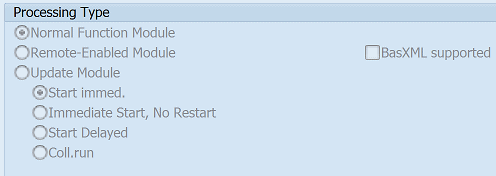SAP CLMM_MAINTAIN_CLASSIFICATIONS Function Module for Mass Operations on Object Classifications
CLMM_MAINTAIN_CLASSIFICATIONS is a standard clmm maintain classifications SAP function module available within SAP R/3 or S/4 Hana systems, depending on your version and release level. It is used for Mass Operations on Object Classifications processing and below is the pattern details for this FM, showing its interface including any import and export parameters, exceptions etc. there is also a full "cut and paste" ABAP pattern code example, along with implementation ABAP coding, documentation and contribution comments specific to this or related objects.
See here to view full function module documentation and code listing for clmm maintain classifications FM, simply by entering the name CLMM_MAINTAIN_CLASSIFICATIONS into the relevant SAP transaction such as SE37 or SE38.
Function Group: CLMM
Program Name: SAPLCLMM
Main Program: SAPLCLMM
Appliation area:
Release date: 30-Nov-1999
Mode(Normal, Remote etc): Normal Function Module
Update:

Function CLMM_MAINTAIN_CLASSIFICATIONS pattern details
In-order to call this FM within your sap programs, simply using the below ABAP pattern details to trigger the function call...or see the full ABAP code listing at the end of this article. You can simply cut and paste this code into your ABAP progrom as it is, including variable declarations.CALL FUNCTION 'CLMM_MAINTAIN_CLASSIFICATIONS'"Mass Operations on Object Classifications.
EXPORTING
CLASS_TYPE = "Class Type
OBJECT_TABLE = "Name of Database Table for Object
* KEY_DATE = SY-DATUM "Valid-From Date
* CHANGE_NUMBER = "Change Number
* NEW_LOG = 'X' "Log Control - See Documentation
* TEST_RUN = "Test Mode - Not Saved
TABLES
OBJECTS = "Objects in Search Result
* CLASS_ALLOCS_SET = "Classes to Which Objects are Being Assigned
* CLASS_ALLOCS_DEL = "Assignments to be deleted
* VALUATION_OLD = "Communication for Characteristics/Values
* VALUATION_NEW = "Communication for Characteristics/Values
EXCEPTIONS
VALUATION_MISSING = 1
Customer Function user exits
Below is a list of CUSTOMER FUNCTION exit user exits that are available within this program and maybe relevant for this FM.EXIT_SAPLCLMMD_001 Selection of Objects for Mass Processing
IMPORTING Parameters details for CLMM_MAINTAIN_CLASSIFICATIONS
CLASS_TYPE - Class Type
Data type: KLASSENARTOptional: No
Call by Reference: No ( called with pass by value option)
OBJECT_TABLE - Name of Database Table for Object
Data type: TABELLEOptional: No
Call by Reference: No ( called with pass by value option)
KEY_DATE - Valid-From Date
Data type: DATUVDefault: SY-DATUM
Optional: Yes
Call by Reference: No ( called with pass by value option)
CHANGE_NUMBER - Change Number
Data type: AENNROptional: Yes
Call by Reference: No ( called with pass by value option)
NEW_LOG - Log Control - See Documentation
Data type: FLAGDefault: 'X'
Optional: Yes
Call by Reference: No ( called with pass by value option)
TEST_RUN - Test Mode - Not Saved
Data type: FLAGOptional: Yes
Call by Reference: No ( called with pass by value option)
TABLES Parameters details for CLMM_MAINTAIN_CLASSIFICATIONS
OBJECTS - Objects in Search Result
Data type: TT_CLSEL_OBJECTSOptional: No
Call by Reference: Yes
CLASS_ALLOCS_SET - Classes to Which Objects are Being Assigned
Data type: TT_ALLOCATION_CLASSESOptional: Yes
Call by Reference: Yes
CLASS_ALLOCS_DEL - Assignments to be deleted
Data type: TT_ALLOCATION_CLASSESOptional: Yes
Call by Reference: Yes
VALUATION_OLD - Communication for Characteristics/Values
Data type: TT_COMWOptional: Yes
Call by Reference: Yes
VALUATION_NEW - Communication for Characteristics/Values
Data type: TT_COMWOptional: Yes
Call by Reference: Yes
EXCEPTIONS details
VALUATION_MISSING - No Assigned Values Were Specified
Data type:Optional: No
Call by Reference: Yes
Copy and paste ABAP code example for CLMM_MAINTAIN_CLASSIFICATIONS Function Module
The ABAP code below is a full code listing to execute function module POPUP_TO_CONFIRM including all data declarations. The code uses the original data declarations rather than the latest in-line data DECLARATION SYNTAX but I have included an ABAP code snippet at the end to show how declarations would look using the newer method of declaring data variables on the fly. This will allow you to compare and fully understand the new inline method. Please note some of the newer syntax such as the @DATA is not available until a later 4.70 service pack (SP8), which i why i have stuck to the origianl for this example.| DATA: | ||||
| lt_objects | TYPE STANDARD TABLE OF TT_CLSEL_OBJECTS, " | |||
| lv_class_type | TYPE KLASSENART, " | |||
| lv_valuation_missing | TYPE KLASSENART, " | |||
| lv_object_table | TYPE TABELLE, " | |||
| lt_class_allocs_set | TYPE STANDARD TABLE OF TT_ALLOCATION_CLASSES, " | |||
| lv_key_date | TYPE DATUV, " SY-DATUM | |||
| lt_class_allocs_del | TYPE STANDARD TABLE OF TT_ALLOCATION_CLASSES, " | |||
| lv_change_number | TYPE AENNR, " | |||
| lt_valuation_old | TYPE STANDARD TABLE OF TT_COMW, " | |||
| lv_new_log | TYPE FLAG, " 'X' | |||
| lt_valuation_new | TYPE STANDARD TABLE OF TT_COMW, " | |||
| lv_test_run | TYPE FLAG. " |
| CALL FUNCTION 'CLMM_MAINTAIN_CLASSIFICATIONS' "Mass Operations on Object Classifications |
| EXPORTING | ||
| CLASS_TYPE | = lv_class_type | |
| OBJECT_TABLE | = lv_object_table | |
| KEY_DATE | = lv_key_date | |
| CHANGE_NUMBER | = lv_change_number | |
| NEW_LOG | = lv_new_log | |
| TEST_RUN | = lv_test_run | |
| TABLES | ||
| OBJECTS | = lt_objects | |
| CLASS_ALLOCS_SET | = lt_class_allocs_set | |
| CLASS_ALLOCS_DEL | = lt_class_allocs_del | |
| VALUATION_OLD | = lt_valuation_old | |
| VALUATION_NEW | = lt_valuation_new | |
| EXCEPTIONS | ||
| VALUATION_MISSING = 1 | ||
| . " CLMM_MAINTAIN_CLASSIFICATIONS | ||
ABAP code using 7.40 inline data declarations to call FM CLMM_MAINTAIN_CLASSIFICATIONS
The below ABAP code uses the newer in-line data declarations. This allows you to see the coding differences/benefits of the later inline syntax. Please note some of the newer syntax below, such as the @DATA is not available until 4.70 EHP 8.| DATA(ld_key_date) | = SY-DATUM. | |||
| DATA(ld_new_log) | = 'X'. | |||
Search for further information about these or an SAP related objects